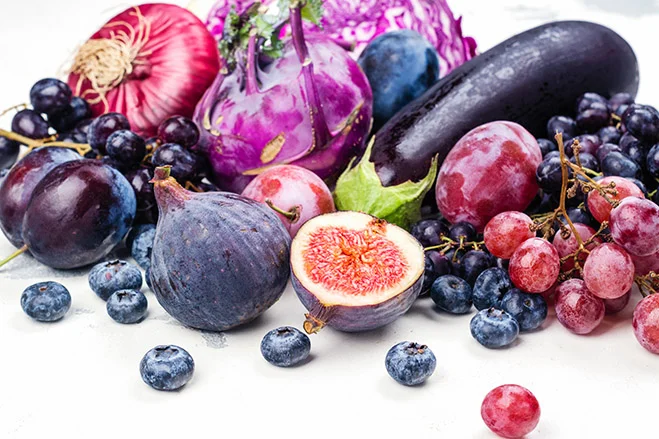Anthocyanins are natural pigments in various fruits, vegetables, and flowers, giving them vibrant red, purple, and blue hues. These water-soluble pigments belong to the flavonoid group and are widely used as natural food colorants. The use of anthocyanins in the food industry is not only driven by their aesthetic appeal but also by their potential health benefits. This blog explores the origins, applications, benefits, and challenges of using anthocyanin as a food colorant.
Origins and Sources of Anthocyanins
Anthocyanins are derived from several plant sources, including:
- Berries: Blueberries, blackberries, raspberries, and elderberries are rich in anthocyanins, contributing to their deep, attractive colors.
- Grapes: Both red and black grapes contain high levels of anthocyanins, also present in red wine.
- Vegetables: Red cabbage, purple corn, and eggplants are notable vegetable sources.
- Flowers: Certain flowers, such as hibiscus and blue peas, are used in traditional and culinary applications for their vibrant anthocyanin content.
These sources are abundant and provide a natural alternative to synthetic food colorings, aligning with the growing consumer demand for clean-label products.
Applications in the Food Industry
Anthocyanins are used in many food products to enhance visual appeal and provide a natural coloring solution. Key applications include:
- Beverages: Anthocyanins impart rich colors and enhance the visual experience in fruit juices, sodas, teas, and alcoholic beverages.
- Confectionery: Candies, gummies, and chocolates benefit from anthocyanin extracts’ vibrant reds and purples.
- Dairy Products: Yogurts, ice creams, and milkshakes often use anthocyanins to create appealing shades without compromising natural ingredients.
- Baked Goods: Anthocyanin-based food colorings can be used to achieve desirable colors in pastries, cakes, and frostings.
- Snacks: Chips, crackers, and cereals utilize these natural pigments to differentiate products and attract consumers.
Health Benefits of Anthocyanins
Beyond their coloring properties, anthocyanins are celebrated for their potential health benefits, contributing to their popularity as food additives. These benefits include:
- Antioxidant Properties: Anthocyanins have strong antioxidant effects, helping to neutralize free radicals and reduce oxidative stress in the body.
- Anti-Inflammatory Effects: Regular consumption of anthocyanin-rich foods may help reduce inflammation linked to various chronic diseases.
- Heart Health: Studies suggest that anthocyanins can improve cardiovascular health by enhancing blood vessel function and reducing blood pressure.
- Cognitive Function: There is evidence that anthocyanins may support brain health, improving memory and cognitive function.
- Anti-Cancer Potential: Some research indicates that anthocyanins may have anti-cancer properties, inhibiting the growth of cancer cells.
These health benefits make anthocyanins attractive for food manufacturers looking to market health-conscious products.
Challenges and Considerations
Despite their advantages, the use of anthocyanins as food colorants comes with certain challenges:
- Stability: Anthocyanins can be sensitive to pH, light, and temperature, which can affect the stability and intensity of the color in various food matrices.
- Cost: Natural colorants, including anthocyanins, can be more expensive to produce and source than synthetic dyes.
- Color Range: While anthocyanins offer a beautiful palette of reds, purples, and blues, their color range is limited compared to synthetic food color alternatives that provide a broader spectrum.
- Regulatory Approval: Using natural colorants requires careful consideration of regulatory standards, which vary by region and can impact formulation and labeling.
Future Prospects
The future of anthocyanins in the food industry looks promising, driven by the following trends:
- Clean Label Movement: Consumers increasingly demand transparency and natural ingredients in their food products. Anthocyanins align perfectly with this trend, offering a natural and recognizable ingredient.
- Innovative Applications: Ongoing research and development are expanding the applications of anthocyanins, including encapsulation techniques to improve stability and functionality.
- Sustainable Sourcing: Advances in agricultural practices and biotechnology may enhance the sustainable production of anthocyanin-rich plants, reducing costs and environmental impact.
Conclusion
Anthocyanin food color offers a compelling combination of vibrant hues, natural origins, and potential health benefits. While there are challenges to their use, the growing consumer preference for natural and healthful ingredients is likely to drive their increased adoption in the food industry. As technology and sourcing methods improve, anthocyanins could become a staple in formulating colorful, appealing, and nutritious food products.




0 Comments